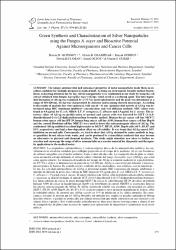| dc.contributor.author | Altınsoy, Berrak | |
| dc.contributor.author | Özakpınar, Özlem | |
| dc.contributor.author | Gürbüz, Burçak | |
| dc.contributor.author | Rayaman, Pervin | |
| dc.contributor.author | Öçsoy, İsmail | |
| dc.contributor.author | Soyoğul Gürer, Ümran | |
| dc.date.accessioned | 2019-01-08T11:52:35Z | |
| dc.date.available | 2019-01-08T11:52:35Z | |
| dc.date.issued | 2018-03-29 | |
| dc.identifier.issn | 0326 2383 | |
| dc.identifier.issn | 2362-3853 | |
| dc.identifier.uri | http://hdl.handle.net/11363/821 | |
| dc.description.abstract | The unique antimicrobial and anticancer properties of metal nanoparticles made them an excellent candidate for multiple purposes in medical field. As being an environment friendly method biosynthesis, is drawing attention day by day. Silver nanoparticles were synthesized in our study by using the cell extract obtained from fungus Aspergillus niger (AGAg), which acted as a reducing agent. The time-dependent formation of AGAg was examined by a UV-Vis spectrophotometer and the peak was determined at a range of 410-420 nm. AGAg was characterized by zetasizer and scanning electron microscopy. According to the results of analyzis they were spherical, with size of ~ 61 nm. Antimicrobial activity of AGAg was determined using MIC (minimum inhibitory concentration) and well diffusion methods. MIC values were found as 0.9 μg/mL for E. coli, MRSA- LY, P. aeruginosa, C. albicans and 1.9 μg/mL for S. aureus. The cytotoxic effect of AGAg on proliferation of normal and cancer cells was detected by MTT (3-(4,5- dimethylthiazol-2-yl)-2,5-diphentyltetrazolium bromide) method. Human breast cancer cell line MCF-7, human colon cancer cell line HT-29, human lung cancer cell line A549, human liver cancer cell line Hep3b and the control fibroblast cell line NIH3T3 were used to detect the anticarcinogenic effects of AGAg. The synthesized AGAg exhibited excellent high toxicity on MCF-7, HT-29, A549, Hep3b cells (68%, 89, 87, and 81%, respectively) and had a dose-dependent effect on cell viability. It was found that AGAg caused 34% inhibition on normal cells. Consequently, we tried to show that AGAg obtained by easier methods in larger quantities do not release toxic waste, and can be produced by extracellular synthesis that may become an alternative to physical and chemical synthesis. This study might stimulate new ideas to further researches and encourage the usage of silver nanoparticles as a carrier material for diagnostic and therapeutic applications in the medical sector. | en_US |
| dc.language.iso | eng | en_US |
| dc.publisher | College of Pharmacists | en_US |
| dc.relation.isversionof | 10.1080/02640410500249357 | en_US |
| dc.rights | info:eu-repo/semantics/openAccess | en_US |
| dc.rights | Attribution-NonCommercial-NoDerivs 3.0 United States | * |
| dc.rights.uri | http://creativecommons.org/licenses/by-nc-nd/3.0/us/ | * |
| dc.subject | Research Subject Categories::SOCIAL SCIENCES::Social sciences::Social work::Sports research | en_US |
| dc.title | Green Synthesis and Characterization of Silver Nanoparticles using the Fungus A. niger and Bioactive Potential Against Microorganisms and Cancer Cells | en_US |
| dc.type | article | en_US |
| dc.relation.ispartof | Latin American Journal of Pharmacy | en_US |
| dc.department | İstanbul Gelişim Üniversitesi | en_US |
| dc.identifier.volume | 37 | en_US |
| dc.identifier.issue | 5 | en_US |
| dc.identifier.startpage | 979 | en_US |
| dc.identifier.endpage | 986 | en_US |
| dc.relation.publicationcategory | Kategori Yok | en_US |



















